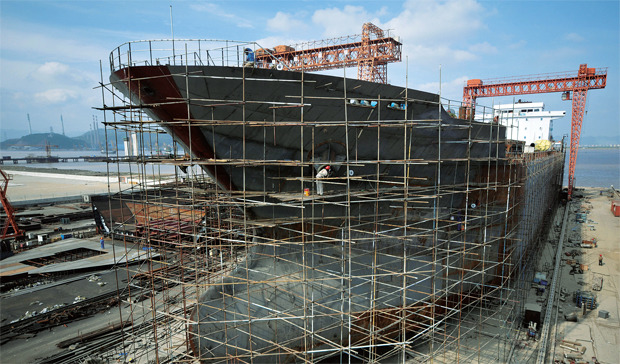Global Orderbook on the Rise After First Quarter

The global orderbook rose by about 160 vessels after the end of the first quarter of 2023, despite lower annual activity. In its latest weekly report, shipbroker XClusiv said that “as the first quarter of 2023 ended, the total orderbook of the four main components of the merchant fleet has increased by about 160 vessels (6.5%) compared to the end of the first quarter of 2022. The orderbooks of dry bulk, container and gas carrier segments have seen their numbers increase by 19%, 16% and 31% respectively but on the other side tanker orderbook saw its numbers drop almost by half, in fact by more than 40%. Despite the total orderbook increase, the first quarter of 2023 is characterized by fewer new contracts than in Q1/2022, something that may indicate a pause in interest and demand in the market for newbuildings as the slots are too far forward and prices are remaining firm”..

According to Xclusiv, “within the first quarter of 2023 the new contracts at the four main segments are 201, while at the same period of 2022 the new contracts were more than double, at 435 contracts and in Q1/2021 were 586. Owners and investors have really dropped their appetite for bulkers and containers as these two segments show the strongest reduction in demand for new contracts with the bulker orderbook having only 38 new contracts in Q1/2023 and container orderbook having only 37 new contracts in comparison to Q1/2022 when new contracts where 143 and 158 respectively. Gas carrier orderbook has also seen NB numbers going down by 15 contracts, from 52 new contracts in Q1/2022 to only 37 contracts in the same period of 2023. Tanker orderbook is the one which has significantly firmed its numbers despite the loss in the sum of the orders, from only 24 new orders in Q1 2022 to 64 orders in Q1 2023. This points out that the significant reduction of the total tanker orderboook is mainly due the hesitation of owners within 2022 to place new orders and as the wet market freight rates seem sustainable and have gradually improved further towards the end of 2022, the investing interest returned to the tanker newbuilding segment”.
The shipbroker added that “it’s not only the shipbuilding activity that has increased during the last years but also the newbuilding prices continue to gradually increase, following the upward trend that has started since 2021. Its noteworthy that most of the newbuilding prices in 2023 are about 28% – 38% higher that the Q1/2021 and only about 2.5%-5% higher than in Q1/2022. Price increases were mainly due to the significant rise of the shipbuilding cost, as raw materials, energy and salaries moved expectantly higher, but also due to the competition between buyers for the few remaining yard slots. The general strengthening of the US Dollar (that started within the Q2 of 2022) against the main shipbuilding currencies like Yuan, Yen, Won and Euro has significantly helped to restrict the prices’ increase within 2022 to just 2.5%-5%.

Asian yards are dominating the newbuilding market at the four main vessel segments, with Chinese, Japanese and South Korean yards together accounting for about 93% in 2021 and 95% in 2022 of the orderbook in Dry bulk, Tanker, Container and Gas Carrier segments by number of orders. Chinese yards are totally dominating the dry bulk and container newbuilding market with more than 60% market share in both Q1/2022 and Q1/2023, while South Korean yards are leaders in the gas carrier newbuilding market with a market share of almost 70% in both Q1/2022 and Q1/2023. Newbuilding deliveries for 2023 in Q1/2023 are significantly increased comparing to the deliveries for 2022 in Q1/2022 both in deadweight and number of vessels, at 72.53 m dwt (45.55 m dwt in Q1/2022) and 983 vessels (761 in Q1/2022). Meanwhile the orderbook to fleet ratio in terms of vessels is 6.7% for dry bulk (6% Q1/2022), 4.4% for tankers (7.3% Q1/2022), 15.7% for containers ( 15.4% Q1/2022) and 20.4% for gas carriers (16.5% Q1/2022) and in terms of million DWT its almost the same percentage for dry bulk ( 6.9% Q1/2023/6.6% Q1/2022) and tankers ( 3.8% Q1/2023/6.4% Q1/2022)and it is 28.9% (26.5% Q1/2022) for containers in terms of million TEU and 40.8% (30.1% Q1/2022) in gas carriers in term of million CBM”, Xclusiv concluded.
- 4/26/2023
- Shipping News

